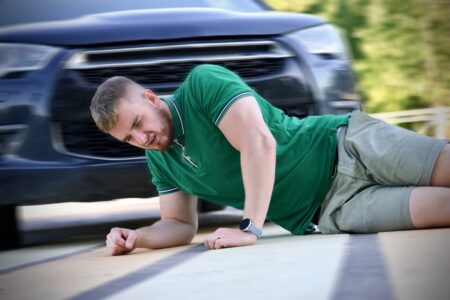There is a common belief that pedestrians always have the right-of-way. In truth, they often do. However, like other roadway users, they must yield the right-of-way in certain circumstances, such as when crossing the road outside an intersection. Here is a look at when pedestrians have the right-of-way, the responsibilities of motorists to avoid causing harm to pedestrians, and why right-of-way matters if you’re injured in an accident. A New York pedestrian accident attorney can help you in this situation.
What Is Right-of-Way, and How Does It Affect Pedestrian Accident Claims?
The Governors Highway Safety Association reports that more than 7,400 people die annually in pedestrian accidents across the U.S., with significant increases in pedestrian deaths and injuries across the nation in the past few years.
 Some of the most common causes of pedestrian accidents include:
Some of the most common causes of pedestrian accidents include:
- Speeding drivers. Excess speed makes it harder for a driver to maintain control of their vehicle and deprives them of the time they need to perceive a hazard, such as a pedestrian entering the roadway, and to respond by applying their brakes. Speeding increases the force of the accident, resulting in more significant injuries and increased fatalities.
- Distracted drivers. Using a handheld electronic device or engaging in other activities while driving can result in pedestrian deaths. As noted by the National Highway Traffic Safety Administration (NHTSA), in the time it takes for a driver to read or reply to a text, their vehicle can travel the length of a football field while they’re not looking at the road. This is ample opportunity for a light to change and a pedestrian to step into the crosswalk unnoticed.
- Failure to yield the right-of-way. While pedestrians are supposed to yield at certain times, the responsibility is often on the driver to ensure that the roadway is clear before moving forward. Even when pedestrians cross outside of an intersection, the driver must yield.
- Driving while impaired. A disproportionate amount of pedestrian accidents involve alcohol impairment. Alcohol deprives a driver of the skills they need to operate their vehicle safely, such as the ability to detect signal changes and movements in their periphery that could be a pedestrian entering the roadway. Alcohol also creates difficulty for the driver in maintaining a single lane of travel, placing pedestrians at risk of being struck while walking by a vehicle drifting in and out of lanes.
One of the most challenging aspects of using public roads is determining right-of-way. Right-of-way determines which lanes of traffic are permitted to travel and which must stop at a stop sign or traffic light to allow vehicles in other travel lanes to proceed through an intersection.
Determining the right-of-way is important when a pedestrian is injured in an accident, as it can help show who was liable for the accident. Failing to yield the right-of-way to a pedestrian or to exercise a duty of care is negligent behavior, invoking the liability of the motorist involved in the accident.
When Pedestrians Have the Right-of-Way?
Nearly every state in the nation has laws prohibiting pedestrians from suddenly running out, conducting business, or soliciting rides while in the road. Pedestrians must obey traffic signals. Law encourage pedestrians to cross where there is a marked or unmarked intersection or where there is a sufficient traffic gap to cross outside of an intersection safely.
At Marked or Unmarked Intersections
Most states, including New York, require pedestrians to use marked or unmarked intersections to cross a road when possible. It should be noted that a marked intersection is an intersection that has lines on the road indicating a crosswalk.
These areas generally have walk/don’t walk traffic signals for pedestrians to use to know when it is safe to cross. But nearly all intersections are technically crosswalks, as long as they don’t feature a sign prohibiting pedestrians from crossing. Drivers must yield the right-of-way to a pedestrian crossing an unmarked intersection.
Right-of-Way on Sidewalks and in Parking Lots
Where sidewalks are available, pedestrians generally have the right-of-way. This means that drivers pulling into or out of private residences must stop before the sidewalk and ensure that the path is free of pedestrians before continuing. Pedestrians also have the right-of-way in parking lots, with drivers required to look for them before pulling into or out of a parking spot.
While it would seem that a parking lot is unlikely for any accident to occur, the National Safety Council notes that tens of thousands of accidents occur in parking lots or garages each year, resulting in hundreds of deaths and thousands of injuries. Pedestrians are often killed or injured when traveling to or from their vehicles. One of the most common causes of parking lot pedestrian accidents is distracted drivers. According to a National Safety Council public opinion poll, 66 percent of drivers make phone calls while they’re navigating a parking lot.
Other parking lot behaviors that can cause a pedestrian accident include:
- Programming the GPS. Sixty-three percent of poll respondents said they program the GPS while in the parking lot.
- Texting. Fifty-six percent of respondents admitted to texting.
- Using social media. Fifty-two percent of respondents stated that they use social media in parking lots.
- Fifty percent of respondents admitted to sending or receiving emails while driving.
- Forty-nine percent of drivers participating in the poll confessed to taking photos or watching videos while driving.
The Driver’s Duty of Care
Drivers have a legal duty to take reasonable actions to avoid causing harm to others. This is known as the driver’s duty of care.
The reasonable actions required generally include:
- Properly maintaining vehicles and purchasing the required minimum insurance to operate on public roads. Maintaining the vehicle can prevent important systems from going out, such as the brakes, and avoid accidents. Maintaining insurance is a legal requirement to compensate those injured as a result of the driver’s carelessness or recklessness, or in no-fault insurance states to provide compensation for the driver if they are injured as either a driver or pedestrian through their personal injury protection (PIP) coverage.
- Operating the vehicle safely and legally, avoiding reckless behaviors such as alcohol impairment, distracted driving, or speeding.
- Stopping for pedestrians, even when the driver has the right-of-way. Failing to stop for a pedestrian outside the crosswalk increases the risks of that individual incurring serious injuries or even death. It also increases the likelihood that the driver will be liable for failing to take reasonable actions to avoid causing harm.
Right-of-Way When Exiting a Bus or In Areas Where Children Commonly Play
As reported by NHTSA, millions of children ride school buses nearly every day of the week. In comparison, fewer than 1 percent of all traffic accident fatalities involve children killed in school transportation accidents. However, the same cannot be said for the number of children killed as pedestrians while attempting to get on or off the bus.
Drivers owe children on or near a road a higher duty of care than for adult pedestrians, as every state in the nation understands that children often lack the awareness and ability to gauge distances needed for safe roadway crossing.
Some additional responsibilities that drivers have for children include:
- Using extra caution in areas near schools, parks, or neighborhoods where children play. Often, school areas feature reduced speed limits and crossing guards to prevent collisions involving vehicles and children.
- Drivers cannot pass stopped school buses with their flashing lights and stop arm deployed. The risk of injury or death is high in such situations, as children and their caretakers walk across the road to enter or exit the bus but are often not seen by drivers behind the bus.
Who Has the Right-of-Way: Scenarios
Beyond helping an injured pedestrian to determine liability in a pedestrian accident claim, right-of-way laws are typically a standard set of rules that help to keep traffic flowing smoothly.
Here is a look at the responsibilities of a driver in certain scenarios, as provided by DefensiveDriving.org:
- Turning right on the green arrow: The right-turning driver has the right-of-way, but only if there are no pedestrians in the crosswalk of the street they are turning.
- Turning right on a green light: Again, drivers have the right-of-way but must ensure that the crosswalk is clear. (Remember, crosswalks are on all sides of an intersection, even if they’re not marked).
- Turning right at a red light: The driver does not have the right-of-way and must stop. If the crosswalk is clear and there is an opening in traffic, the driver can complete their turn.
- Turning left on a green arrow: The driver has the right-of-way but must ensure that the crosswalk is clear, even if the pedestrian signals state “Don’t Walk.”
- Turning left on a green light: The drivers traveling straight through the intersection from the opposite travel lanes have the right-of-way. When there is a sufficient gap in traffic to complete the turn, the left-turning driver can go, but they must make sure the crosswalk is clear.
- Driving straight through an area with no intersections: The driver has the right-of-way but must always exercise a duty of care to prevent injuries to pedestrians by traveling within the posted speed limit and looking for pedestrians, particularly in low-light situations.
Proving Liability in a Pedestrian Accident Claim
If a pedestrian accident injures you, your attorney will conduct a thorough investigation of the accident to determine all liability sources. These accidents often feature a single vehicle with a driver failed their duty of care. To prove your claim, your attorney must demonstrate that the driver’s negligence caused the accident.
You can prove negligence by establishing:
- The at-fault driver owed other users of a public roadway a duty of care.
- The driver breached their duty of care when they took risky or illegal contrary to avoiding causing harm to others.
- Because of the breach, a pedestrian accident occurred in which you were injured.
The evidence used to prove negligence (and liability) include the accident report prepared by the police officer who investigated the scene, photos of the crash and your injuries, witness statements, footage from area surveillance cameras used by businesses or residences, and testimony from accident reconstruction experts.
Your legal team will also gather documentation to prove the expenses of your injury, such as the cost of your medical treatment, lost wages, and even the psychological impacts you incurred as a result of the accident.
Pedestrians Are Vulnerable Road Users

Pedestrians are at a disadvantage on streets designed to move motor vehicles from one place to another as quickly as possible. They do not have the protection of a vehicle’s steel frame, seat belts, and airbags. They are far outsized by the fast-moving vehicles they share a road with, and many places even lack the safety of a sidewalk to provide a little distance between their bodies and vehicles.
Pedestrians don’t always have the right-of-way, but drivers on public roadways must always do their part to avoid causing them harm.
If a pedestrian accident you injured, Connect with our law firm near you for your free case evaluation.
